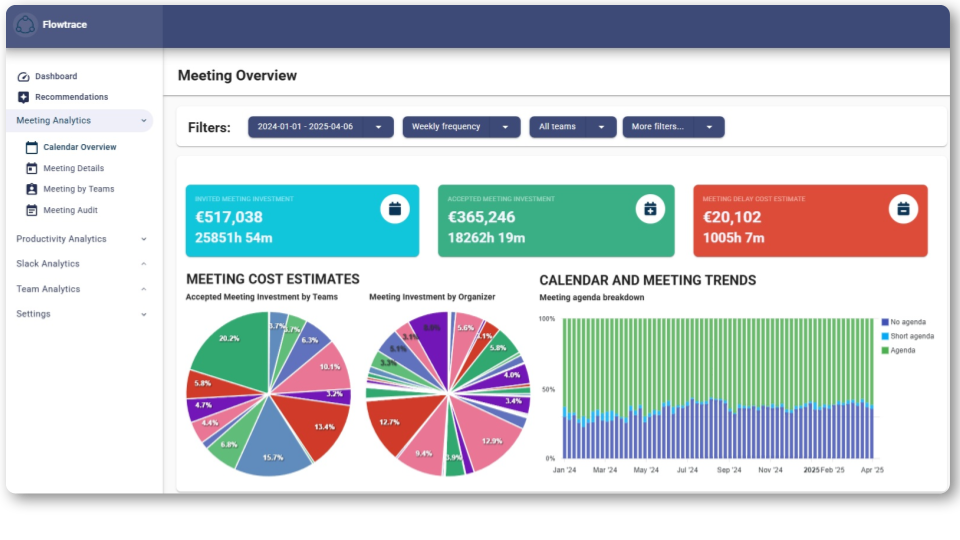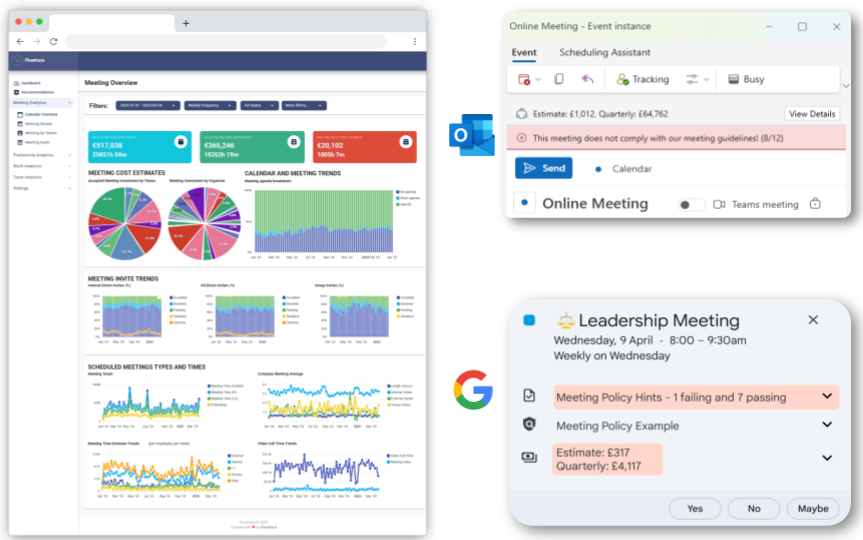How to Reduce Meeting Fatigue
Combat meeting fatigue with a data-driven system that optimizes schedules, enforces agendas, and promotes focused work for fewer, more effective...
Streamline meetings with a manifesto to reclaim focus time. Learn to craft, implement, and measure meeting principles for fewer, clearer, and more productive sessions.
What would your quarter look like if a large slice of your working week disappeared into meetings that didn’t move work forward? That’s not hypothetical. Research found that 55% of UK office workers say meetings stop them doing their jobs, a direct hit to focus time and delivery velocity.
Meeting overload isn’t just a calendar hygiene problem. It’s cultural. Meetings get scheduled by default, not by design. Agendas are fuzzy. Attendee lists balloon. Recurring sessions live forever. Actions go nowhere. Meanwhile, makers lose the uninterrupted blocks they need for real work.
This article lays out a different path: adopt a meeting manifesto, a short, explicit set of operating principles that your organisation lives by. You’ll learn how to craft one, embed it with analytics, and use Flowtrace to understand the data behind it. The aim is simple: fewer, smaller, clearer meetings, and more time for deep work.
Poor meeting habits quietly tax the business:
The impact is predictable: fragmented calendars, rising context switching, and less time for design, analysis, drafting, code, or client work. The right response isn’t performative “No meeting Fridays.” It’s setting a clear, shared standard and backing it with measurement.
If you want one framing number to create urgency with leadership: many senior revenue leaders report spending 20–30 hours per week in meetings. That’s a full-time job’s worth of synchronous time layered on top of their actual role.
A meeting manifesto is a concise set of principles that define when, how, and why you meet. It is:
It’s operational. Teams use it to audit behaviour, adjust templates, and set expectations for organisers and attendees.
Two public examples show the spirit:
Your version should be shorter than a page, specific to your work, and measurable.
Use this process to turn opinion into an operating standard. Start by diagnosing your meeting load, align on a short set of rules, publish and embed them in calendar templates, instrument compliance with analytics, and review quarterly. It scales cleanly from a single team to the entire company and keeps the focus on decisions, not ceremony.
Start with the facts, not opinions. Map:

For recurring sessions, review each one and ask: What decision or outcome does this drive? Why does it still exist? A simple tiering (keep, reduce frequency, retire) will free capacity fast.
If you need an internal narrative hook, point to how revenue leaders describe material time reclaimed after pruning recurring meetings, not “meeting-free days,” just fewer zombie series that no longer serve a purpose.
Run a short workshop with functional leaders and a handful of individual contributors. Keep it practical:
Draft 8–12 manifesto statements (see section 5) that anyone can understand. Decide how they will show up in daily tools: calendar templates, agenda docs, decision logs.
Publish the manifesto as a living document. Seed it into:
Principles without measurement fade. This is where Flowtrace turns guidelines into practice:

If you’re starting small, run a 90-day pilot with one or two departments. Flowtrace’s calendar integrations make this tractable, and you can benchmark before/after to quantify time released. For practical background on measurement methods and cost translation, Flowtrace can support building a meeting culture with analytics and the meeting cost calculator.
Quarterly, audit against the manifesto:
Close the loop with recognition. Spotlight teams that cut attendance while raising output. Share before/after calendars (with names redacted if needed) to show fragmentation reduced. Treat the manifesto as product: iterate to fit remote/hybrid rhythms and your org’s decision style.
Tailor these to your context and tools:
These statements are standards you can observe, measure, and improve with analytics. If you want inspiration for crisp public examples, study Asana’s “move work forward” bar and Whereby’s “invite fewer people, shorter meetings, listen more” framing; both are clear and easy to operationalise.
A manifesto is the policy. Analytics are the system that makes the policy real. Flowtrace maps how your organisation communicates, meets, and decides using metadata from the tools you already use.

The value shows up in four ways:
1) Visibility
See the meeting load per team, how time fragments across the week, who is hit by recurring series, and where attendance routinely exceeds the decision maker set. Leaders finally get a clean picture of where hours go.
2) Compliance
Measure how well the organisation follows its own rules. For example, track the % of meetings with agenda links, the median attendee count by meeting type, or how many recurring series were re-justified this quarter. These are leading indicators you can improve quickly.
3) Impact
Translate meeting metrics into time and cost. This reframes the conversation from “meeting vibes” to financial outcomes and focus time recovered. If you want to start quantifying today, use Flowtrace’s meeting cost calculator as a quick way to put currency values next to calendar changes.
4) Feedback loop
Use the data to refine the manifesto: if agenda compliance is high but decisions still stall, strengthen decision protocols; if attendance keeps creeping up, enforce a rule that observers consume notes async.
Commit to shipping your first version within a month. Treat it like any other improvement sprint.
Week 1: Baseline and alignment
Week 2: Draft and design
Week 3: Pilot and instrumentation
Week 4: Review and socialise
Connect your existing tools, quantify meeting time and cost, and see how collaboration patterns and decision bottlenecks align with your manifesto. Flowtrace turns calendar and comms metadata (not message content) into clear, leadership-ready views of where work speeds up or stalls, so you can adjust the manifesto and measure the result.
One page or less. If people can’t remember it, they won’t use it. Focus on 8–12 behaviours you can measure and enforce across tools.
Create tagged meeting types with different rules for facilitation intensity, materials, and duration. The core rules still apply: purpose, decision, attendees, and actions.
Publish dashboards, not reprimands. Show the gap between the rule and actual behaviour by team. Ask leaders to sponsor the change and model it in their own calendars.
Report before/after deltas in meeting hours, attendee counts, and fragmentation, plus an estimate of cost avoided. Use Flowtrace’s meeting cost calculator to translate those hours into currency for a clean, comparable ROI view.
You can start with templates and manual audits. But to sustain it, you’ll need consistent measurement. Flowtrace automates the normalisation, attribution, and compliance tracking so you can focus on decisions, not spreadsheets.
Combat meeting fatigue with a data-driven system that optimizes schedules, enforces agendas, and promotes focused work for fewer, more effective...
Discover how Flowtrace integrates calendar analytics, meeting analytics, and video call analytics to revolutionize time management and collaboration...
Discover solutions to common meeting challenges, from reducing unnecessary sessions to enhancing productivity, with practical insights and tools for...